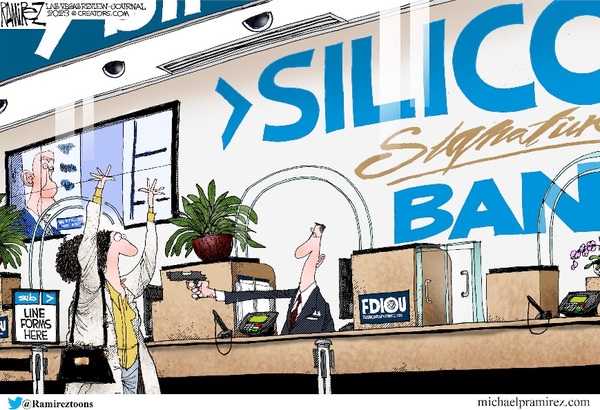
–>
March 19, 2023
This week, a lot of attention has been focused on the collapse of the Silicon Valley Bank. It is, in fact, a story of faulty accounting practices, poor government oversight, and the effects of government micromanaging markets at the same time that it fails in its oversight responsibilities. And you will be paying for it.
‘); googletag.cmd.push(function () { googletag.display(‘div-gpt-ad-1609268089992-0’); }); }
Accounting Shenanigans
Over at the Wall Street Journal, William L. Silber explains this better than anyone, and in terms anyone who ever purchased a government bond can understand. They are safe. The problem is liquidity:
SVB held tens of billions of dollars in long-term government bonds. On its face, this may seem like a prudent investment for a bank, but Treasury securities are riskless only when held to maturity. If you have to sell before then, you can easily lose money if market rates have risen since you first purchased the bond. For example, buying a 10-year U.S. Treasury bond with a 2% coupon at par and holding it for 10 years earns you 2% per annum. But if you sell early and rates have jumped — say, 4% since you bought the bond — then the price will have declined to about $838 per $1,000 face value, meaning you incur a loss of $162 per $1,000 bond.
‘); googletag.cmd.push(function () { googletag.display(‘div-gpt-ad-1609270365559-0’); }); }
The bank officers know, or certainly should know that is the case, and when the Federal Reserve increases interest those bonds are worth far less than an accounting system which shows it as a “held to maturity” item. You have incurred a loss if you have to cash it before maturity. But even so the income from the bond is listed as income, allowing the bank officers and managers to reward themselves handsomely for the “profits” on investment. Now you’d think federal regulators would know this, and they probably did, but looked the other way, for which they seem not to be held accountable.
SVB … held about $90 billion of its $120 billion bond portfolio in its held-to-maturity investment account. As interest rates rose over the past few years, SVB did little to hedge against its exposure to rate hikes. So when depositors came demanding cash, the bank had far less than its book showed.
But that’s not all there is to the story.

Woke Lending and the Biden Role in It
Kim Strassel reports that the bank, at the inducement of the administration lent money to some 1550 companies in the areas of “climate technology and sustainability.” None of these were likely to be profitable, and they put the money SVB lent them on deposit in the bank which bought the government bonds, (Reminds me of Burl Ives song about the old lady who swallowed a fly.
Strassel continues:
‘); googletag.cmd.push(function () { googletag.display(‘div-gpt-ad-1609268078422-0’); }); } if (publir_show_ads) { document.write(“
“We serve those creating positive environmental change,” SVB’s website brags, noting that the bank worked with some 1,550 companies in the “climate technology and sustainability sector.”
Most of these companies weren’t filling some vital market need. Rather, as the Journal reported, SVB was beloved for its willingness to offer “banking services to startups that often weren’t profitable, in some cases didn’t have a product, and would otherwise have a hard time getting a line of credit or a loan from a larger bank.” One tech entrepreneur provided a more scathing description of SVB’s products: “They’re basically subprime business loans. You’re talking about companies that have no credit profile, they’re burning cash and are unlikely to raise the same type of capital because of interest rates. It was basically social credit.”
What inspires a bank to disregard risk and shower money on products or services that nobody is clamoring to buy? One answer is easy money and misguided regulation, which washed dollars into the economy even as it pushed banks like SVB to load up on sovereign debt, lulled by a Federal Reserve-fed belief that interest rates would stay near zero forever. The other? Washington handouts, via President Biden’s effort to engineer a climate industry that otherwise wouldn’t exist.
Strassel amplifies this in a Wall Street Journal editorial, noting that the $1.2 trillion “infrastructure bill” was “a starting gun for a clean-energy frenzy.”
 The act manipulated the market to fund green energy projects rather like Obama’s stimulus bill gave us Solyndra, which after receiving huge federal loan guarantees, collapsed, causing substantial losses.
The act manipulated the market to fund green energy projects rather like Obama’s stimulus bill gave us Solyndra, which after receiving huge federal loan guarantees, collapsed, causing substantial losses.
SVB, in addition to its bond holdings, “further stretched itself by sizably increasing its loans and lines of credit to subprime firms. How much of that would have happened if not for the Biden pot of gold at the end of the green-trach rainbow?” she asks.
In sum, we had lax oversight by regulators; bank officials taking advantage of sloppy accounting practices, a federal government urging loans to companies that otherwise would never be lent money as they never were going to be profitable, bank officers richly rewarding themselves based on phony asset valuations (listing bonds at full, not discounted values), and a Federal Reserve whose lengthy easy money policy lured people into believing this would never end. When the natural result of all the Biden administration sloshing dollars around led to inflation, the Fed had no choice but to tighten supply by raising rates. When they did that, depositors who were paying attention rushed to get their money out of there.
As if government policies had not done enough harm, the FDIC ran in to guarantee depositors, most of whom were over the $250,000 limit for insured deposits.
WASHINGTON – The Federal Deposit Insurance Corporation (FDIC) today transferred all deposits — both insured and uninsured — and substantially all assets of the former Silicon Valley Bank of Santa Clara, California, to a newly created, full-service FDIC-operated ‘bridge bank’ in an action designed to protect all depositors of Silicon Valley Bank.
Depositors will have full access to their money beginning this morning, when Silicon Valley Bridge Bank, N.A., the bridge bank, opens and resumes normal banking hours and activities, including online banking. Depositors and borrowers will automatically become customers of Silicon Valley Bridge Bank, N.A. and will have customer service and access to their funds by ATM, debit cards, and writing checks in the same manner as before. Silicon Valley Bank’s official checks will continue to clear. Loan customers should continue making loan payments as usual.
Silicon Valley Bank was closed by the California Department of Financial Protection and Innovation on Friday, March 10, 2023, and the FDIC was appointed receiver.
The transfer of all the deposits was completed under the systemic risk exception approved yesterday. All depositors of the institution will be made whole. No losses associated with the resolution of Silicon Valley Bank will be borne by taxpayers. Shareholders and certain unsecured debt holders will not be protected. Senior management has also been removed. Any losses to the Deposit Insurance Fund to support uninsured depositors will be recovered by a special assessment on banks, as required by law.
The administration claims it’s not a “bailout,” a claim which is credible only if you believe in fairy tales.
“The FDIC doesn’t have enough funds to cover these losses,” Antoni explained. “If it did, the Federal Reserve would not have had to establish an emergency lending fund on a Sunday evening to backstop the operation. The Fed can simply create the money to cover the losses at these failed banks, which will cause inflation, or the FDIC can do what they did in the last financial crisis and simply get the money from the Treasury, which is a direct cost to taxpayers. Either the American people are on the hook through the hidden tax of inflation or explicit taxes sent to the Treasury.”
I’m humming Ives’ “She swallowed the spider to eat the fly.”
<!– if(page_width_onload <= 479) { document.write("
“); googletag.cmd.push(function() { googletag.display(‘div-gpt-ad-1345489840937-4’); }); } –> If you experience technical problems, please write to [email protected]
FOLLOW US ON
<!–
–>
<!– _qoptions={ qacct:”p-9bKF-NgTuSFM6″ }; ![]() –> <!—-> <!– var addthis_share = { email_template: “new_template” } –>
–> <!—-> <!– var addthis_share = { email_template: “new_template” } –>





